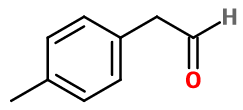
Photo credits: ScenTree SAS
Syringa Aldehyde
Syringua aldehyde ; Seringa aldehyde ; 4-methylbenzene acetaldehyde ; Lilac acetaldehyde ; Para-methylbenzene acetaldehyde ; Syringaldehyde ; Syringa aldehyde ; 2-(4-methylphenyl)acetaldehyde ; Para-tolyl acetaldehyde

Photo credits: ScenTree SAS
Do you sell any of the raw materials? Would you like to let our users know?
Send an email to fournisseurs@scentree.coto learn about our advertising opportunities.
Do you sell any of the raw materials? Would you like to let our users know?
Send an email to fournisseurs@scentree.coto learn about our advertising opportunities.
General Presentation
-
CAS N° : 104-09-6
-
EINECS number : 203-173-2
-
FEMA number : 3071
-
FLAVIS number : 05.042
-
JECFA number : 1023
-
Appearance : Colorless liquid
-
Density : 1,032
-
Volatility : Heart
-
Price Range : €€€€€
Physico-chemical properties
-
Molecular formula : C9H10O
-
Molecular Weight : 134,18 g/mol
-
Log P : 2,21
-
Fusion Point : Donnée indisponible.
-
Boiling Point :
-
Detection Threshold : Donnée indisponible.
-
Optical rotation : Donnée indisponible
-
Vapor pressure : Donnée indisponible
-
Refractive Index @20°C : Donnée indisponible
-
Acid Value : Donnée indisponible.
-
Flash Point : 70°C
Uses
Uses in perfumery :
Syringa Aldehyde is used for mimosa accords, and for its honey and powdery facet in floral notes, also bringing an animalic facet.
Year of discovery :
Data not available.
Natural availability :
Syringa Aldehyde is found in corn oil in small quantity, not allowing to use dit in its natural state.
Isomerism :
Syringa Aldehyde has two positional isomers : ortho-methyl benzyl acetaldehyde and meta-methyl benzyl acetaldehyde. Both are not used in perfumery. Syringa Aldehyde also is a constitutional isomer of Cinnamic Alcohol, although it does not have the same smell.
Synthesis precursor :
Syringa Aldehyde is not used for the synthesis of another compound of olfactive interest.
Synthesis route :
Syringa Aldehyde can be synthesized from para-methylbenzaldehyde, by reacting with a random chloroacetate. This step has to be followed by an acidic hydrolysis of the obtained glycidate, with a subsequent decarboxylation.
Regulations & IFRA
Allergens :
This ingredient does not contain any allergen.
IFRA 51th :
This ingredient is not restricted for the 51th amendment

